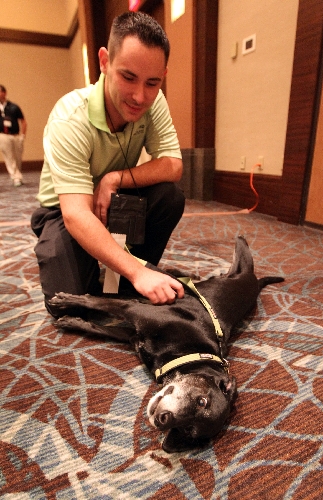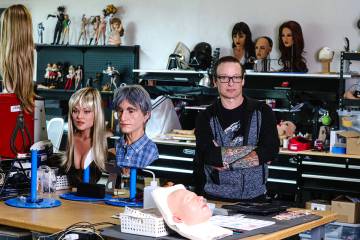Bed bug expo offers tips, eradication items
It's 7 a.m. and about 70 people are gathered in a Red Rock Resort ballroom, munching on bagels while sipping coffee.
While watching the presentation, a slow, creeping itch begins on your left hand. Then you feel it move to your cheek, and pretty soon, the sensation is covering your entire body. You know there's nothing there, but the damage is done. The psychosis has already set in.
Welcome to the 2012 North American Bed Bug Summit.
During Allie Taisey's morning seminar, the research entomologist for BedBug Central showed slides of hundreds of bed bugs clustered in a wall's corner. Simultaneously, a man muttered, "beautiful" in response to the visual.
BedBug Central hosted the seminar-filled summit and expo Thursday and today to educate pest control professionals, the hospitality industry and government officials about the ins and outs of bed-bug detection and eradication. About 450 people attended, which is on par with 2011's numbers.
Phillip Cooper, president of BedBug Central, said the bed bug industry, once over-hyped and oversaturated with businesses, is returning to a more normal state than the 2005-2010 era of fear and loathing. He cited academic research and the maturation of the market as primary reasons.
"That's the trend we're headed toward," he said.
During Taisey's early morning session, she explained that most lay people are still unfamiliar with bed bugs, and that doctors, many times, will misdiagnose their bites as scabies, chicken pox or a rash. For the general public, awareness is the best defense, and if you suspect bed bugs or know of an infestation, it's always best to call in a professional for help.
SLOW TREATMENT COSTLY
If you can't afford a professional's help - cost to eradicate the bugs from a hotel room can be as high as $1,000 per unit - there are still ways to ease your situation.
"The longer an infestation goes, the more costly it is to eradicate," Taisey cautioned.
The little suckers can live in wall hangings or household items, not just bedding. Taisey showed pictures of bugs and eggs inside video tapes stored in a living room as an example.
"Even stuffed animals aren't safe," Taisey said.
Many times, bed bugs go untreated because, Taisey said, people want to avoid attracting attention, they're ashamed, some may be socially or mentally handicapped, visually impaired or just scared to tell someone.
Cooper suggested vacuuming mattresses, making sure to dispose of vacuum contents safely and securely. Purchasing a tight-fitting, white cover for contaminated mattresses also can help contain the bugs or at least make them easier to detect.
Collection devices placed under bed legs, which cost about $5 each, can help trap some of them, but it's a very passive way to treat the bugs and is not a cure, Cooper said.
ERADICATION TIPS AND DEVICES OFFERED
Bed bugs don't jump or fly, so make your bed an island, which will help limit their spread.
"Hot laundering is an effective method of destroying bugs and eggs," Taisey added.
Also be sure to clean up clutter and pay special attention to household items that could serve as landing pads for bed bugs.
"Wicker is like bed bug multifamily housing," Taisey said.
Aside from the educational seminars, the expo floor featured bed bug good riddance products primarily centered around the use of heat and canine detection.
Among the exhibitors was Elizabeth Knote, inventor of the Bed Bug Baker.
Her invention, a heated tent, essentially bakes bed bugs alive at a temperature of 122 degrees. At $4,600 Knote's creation can accommodate up to 22 pieces of large luggage or a queen-size bed.
"My goal is to sell these tents nationwide so we can have a network of heating stations so that if you travel to another city ... you'd have a place to heat your bags before you came home so you wouldn't bring the bed bugs home with you," Knote explained.
At the end of her session, Taisey left the crowd with this bed bug-related nugget: "Communication is key to ebb the tide of this national epidemic."
Contact reporter Laura Carroll at lcarroll@reviewjournal.com or 702-380-4588.





























